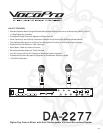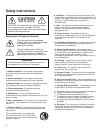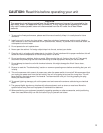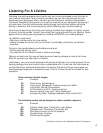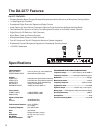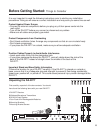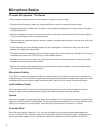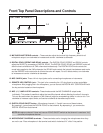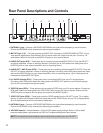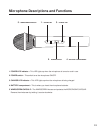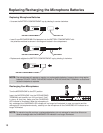
Microphone Basics
7
Wireless Microphones - The Basics
• Every wireless microphone system must operate on a specific frequency range.
• The government dictates the frequency ranges available for use with consumer wireless devices.
• Wireless frequencies are shared with TV stations, communications equipment and a large number of wireless
microphone systems.
• Because of frequency sharing, there is always at least a small chance that someone else in the area might be
using the same frequency as your wireless system.
• There must be one transmitter and one receiver to make a complete wireless system, and they both must be on
the same frequency.
• If the frequencies of any two wireless systems are too close together, interference is likely, and one or both
systems will probably be compromised.
• The practical maximum operating range of a wireless system will vary from as little as 100 feet (30 m) in heavily
crowded indoor situations to 150 feet (40 m) In low crowded situation.
• Wireless receivers must have either one or two external antennas, and there should be a clear open-air path
between these antennas and the transmitter.
• Weak or worn-out transmitter batteries are a common cause of wireless problems, including complete failure,
poor range, distorted audio and interference.
Microphone Position
The DA-2277 wireless microphones are ideal for close-up vocals and can be held in the hand or mounted on a
microphone stand. The most common applications and placement techniques are listed below. Keep in mind that
microphone technique is largely a matter of personal taste—there is no one "correct" microphone position.
Lead & Backup Vocals
Lips should be less than 3" from or even touching the windscreen on an axis to the microphone. Doing this
creates a robust sound, emphasizes bass and provides maximum isolation from other sources.
Speech
When giving a speech or simply speaking, place the microphone 4" to 10" away from the mouth, just above nose
height for a natural sound with reduced bass. You can also place the microphone 8" to 16" away from the mouth,
slightly off to one side, for a more "distant" sound with highly reduced bass and minimal "s" sounds.
Proximity Effect
When the sound source is less than 1/4 in. from the microphone, the microphone boosts bass frequencies
(by 6 to 10 dB at 100 Hz), creating a warmer and richer bass sound than when farther away. This effect, known
as proximity effect, happens only in unidirectional dynamic microphones like those used with the DA-2277.



